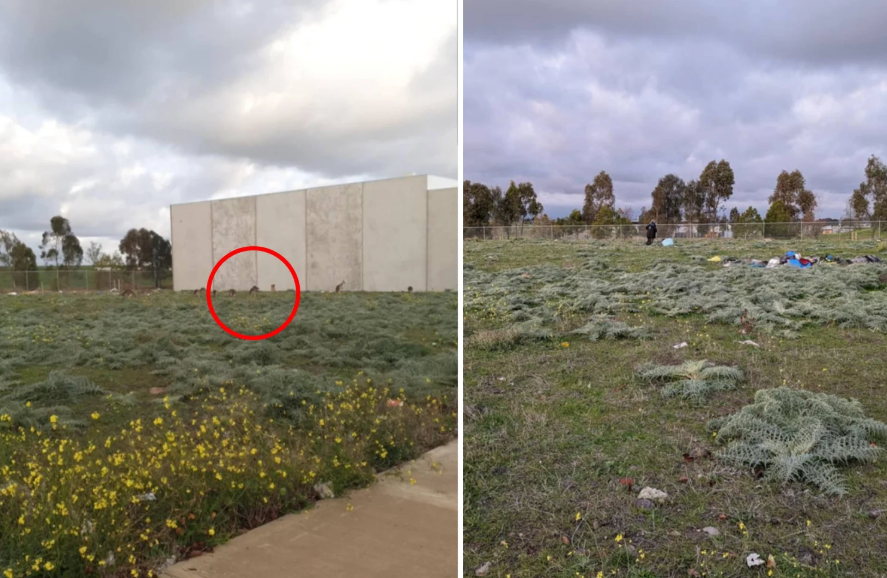
Victoria’s kangaroo rescuers are facing a crisis unlike anything they had seen in years.
A silent roadside threat was leaving mobs of kangaroos stumbling, disoriented, and doomed.
For many volunteers, every rescue ended in the hardest decision of all—humane euthanasia.
The cause was Phalaris aquatica, a tall, blue-green grass introduced to Australia in 1884 and once hailed as an agricultural hero.
Originally brought from the United States and later developed into the ‘Australian’ variety in Toowoomba in 1906, phalaris became a cornerstone of livestock grazing.
Between 1990 and 2020, 4.4 million kilograms of certified CSIRO phalaris seed were sold, covering about 1.48 million hectares across the country.
'This is the worst phalaris season I've ever seen'
Its resilience and rapid growth made it valuable to farmers but also a relentless invader.
Professor Bhagirath Chauhan from the University of Queensland described it as a fast-growing weed with seeds that could take years to germinate.
‘Even if you can stop the seed production in this season, you will get these plants in the next three to four years, definitely,’ he said.
Understanding phalaris staggers
When kangaroos grazed on phalaris in autumn and winter, they risked developing ‘phalaris staggers’.
Wildlife veterinarian Dr Tian Chen explained the grass produced neurotoxins called tryptamine alkaloids during these seasons.
Symptoms began with head wobbles and ears pointing downwards, then progressed to zigzag hopping, tail swaying, circling, and repeated falls.
Recognising phalaris staggers in kangaroos
Head wobbles with ears pointing downward
‘Drunk’ appearance with zigzag hopping
Tail swaying in all directions
Repeated falling when disturbed
Standing with heads pressed against walls
Appearing mentally ‘depressed’ or unaware
May allow humans to approach closely (but remain dangerous)
In the final stages, kangaroos suffered muscle tremors, severe incoordination, and reduced awareness.
‘They may allow people to get very close to them due to their reduced awareness of surroundings, but can still be incredibly dangerous when agitated,’ Dr Chen warned.
The staggering rise in cases
The scale of the problem was unprecedented.
In July, Wildlife Victoria recorded a 433 per cent increase in cases compared to the same month in the previous year, totalling 485 incidents.
Many involved entire mobs, with few successful rescues—though four young joeys were recently saved from their mothers’ pouches.
Why a livestock cure can’t reach wild kangaroos
A solution existed for livestock—oral cobalt treatments that allowed gut bacteria to destroy the toxins—but wild kangaroos could not be treated in the same way.
Cobalt sprays, bullets, and pellets protected sheep and cattle for months or years, but these methods were impossible for free-roaming wildlife.
Did you know?
Cobalt treatment must be given orally to work Injections of Vitamin B12 do not prevent phalaris staggers.
The human toll on rescuers
Rescuers were emotionally and financially exhausted.
‘Most cases are untreatable. Humane euthanasia is often the only option to prevent suffering which is a heavy burden for our rescuers, both emotionally and physically,’ Wildlife Victoria stated.
In just two months, the organisation had spent $100,000 on sedation and euthanasia, and called on the state government for urgent support.
Leonie, a rescuer, described the grim reality: ‘Practically everyone we attend to, we have to euthanise. It’s horrific. It’s a shocking way to die.’
She added that affected kangaroos often became aggressive: ‘They’re just very sensitive to touch. They growl a lot more.’
What to do if you find an affected kangaroo
- Do NOT approach the animal—they can be aggressive and dangerous
- Call Wildlife Victoria on (03) 8400 7300
- Note the exact location and any identifying features
- Stay in your vehicle to monitor until help arrives
- Report to DEECA Customer Contact Centre on 136 186
- Do not attempt to give food or water
Managing the spread
Controlling phalaris was a long and complex process.
DEECA worked with agencies like VicRoads, Parks Victoria, and local councils, using methods such as herbicide spraying, slashing, and ecological burning.
James Todd, DEECA’s Chief Biodiversity Officer, stressed there was ‘no one-size-fits-all approach’ due to the sensitivity of native species.
Wildlife Victoria suggested replacing grazing grass with non-toxic species and eradicating phalaris where possible, but Chauhan believed it could never be fully removed.
Instead, he urged focusing on preventing its spread, given that seeds could be carried by water, animals, and machinery.
Dr Chen recommended exclusion fencing for high-risk areas like golf courses, as well as signage to warn visitors and encourage reporting during the high-risk season.
He estimated the danger period could last three to four months each year.
How you can help
What seniors could do included identifying phalaris on their property, replacing it with native grasses, reporting sick kangaroos, donating to rescue groups, and advocating for native plantings in parks.
They were also urged to keep children and pets away from sick wildlife and drive cautiously in affected areas at dawn and dusk.
What This Means For You
The phalaris crisis was a deadly intersection of agricultural history, climate conditions, and gaps in wildlife protection.
While it could not be erased from the landscape, communities working together could still limit its impact.
Have you ever seen kangaroos suffering from phalaris staggers in your area, and how has it changed the way you think about roadside grass?
Phalaris aquatica (bulbous canarygrass) | CABI Compendium — Details the introduction and spread of Phalaris aquatica in Australia since 1884.
https://www.cabidigitallibrary.org/doi/full/10.1079/cabicompendium.70355
Then, now, and tomorrow of Australian pastures - Valley Seeds — Covers the development of the Australian Phalaris variety in 1906 in Toowoomba’s subtropical climate.
https://valleyseeds.com/pasture-seed-varieties/then-now-and-tomorrow-of-australian-pastures/
Phalaris - CSIRO — Explains Phalaris aquatica as a long-lived pasture grass primarily used for beef and sheep grazing in Australia.
https://www.csiro.au/en/about/corpo...mpact-case-studies/future-industries/phalaris
Cobalt in phalaris staggers — Discusses the use of cobalt treatment to prevent phalaris staggers in livestock and the occasional occurrence of the condition in Victoria.
http://www.flockandherd.net.au/sheep/reader/phalaris-staggers-II.html
Phalaris staggers, a threat to kangaroos, appears in Yarra Ranges | Ranges Trader Star Mail — Reports on the emergence of phalaris staggers in wild kangaroos, describing symptoms and seasonal toxin production.
https://rangestrader.mailcommunity....-threat-to-kangaroos-appears-in-yarra-ranges/
Kangaroo Harvesting Program - Wildlife Victoria — Provides information on management zones and quotas for kangaroo population control in Victoria.
https://www.wildlife.vic.gov.au/our-wildlife/kangaroo-harvesting-program
Phalaris staggers — Describes toxin levels in new Phalaris growth after dry summers followed by autumn rains and the seasonal variation of the condition.
https://www.flockandherd.net.au/edition/poisonousplants2005/phalaris-staggers.html
Phalaris Pastures — NSW Department of Primary Industries publication focusing on agriculture and pasture management including Phalaris species.
https://www.dpi.nsw.gov.au/__data/assets/pdf_file/0007/165049/p251.pdf
Phalaris staggers, a threat to kangaroos, appears in Yarra Ranges | Lilydale Star Mail — Details clinical signs in kangaroos affected by phalaris staggers and potential prevention through cobalt application.
https://lilydale.mailcommunity.com....-threat-to-kangaroos-appears-in-yarra-ranges/
Phalaris staggers, a threat to kangaroos, appears in Yarra Ranges | Ranges Trader Star Mail — Advises on exclusion methods and signage to reduce kangaroo exposure to toxic Phalaris areas.
https://rangestrader.mailcommunity....-threat-to-kangaroos-appears-in-yarra-ranges/
While phalaris poisoning is a hidden danger along our roadsides, other threats to kangaroos can come directly from human interaction.
Feeding wild animals, even with the best intentions, can lead to injuries, illness, and distressing rescue situations.
One recent case revealed just how dangerous this can be when kangaroos became trapped after seeking out food.
Read more: Stop Feeding Kangaroos or Face the Consequences - Shocking Rescues Reveal the Dangers!







